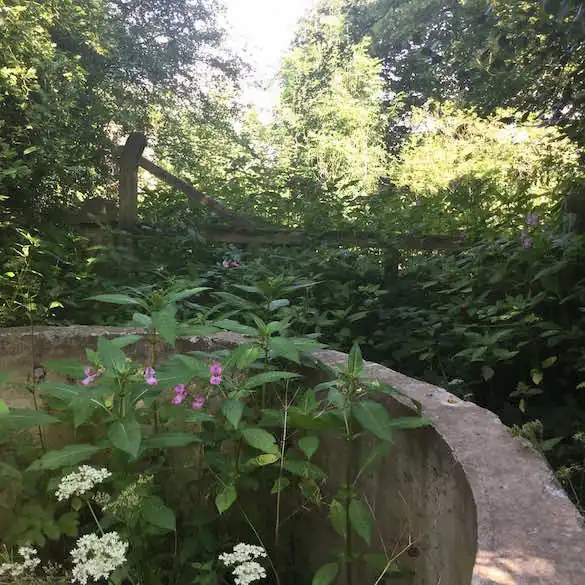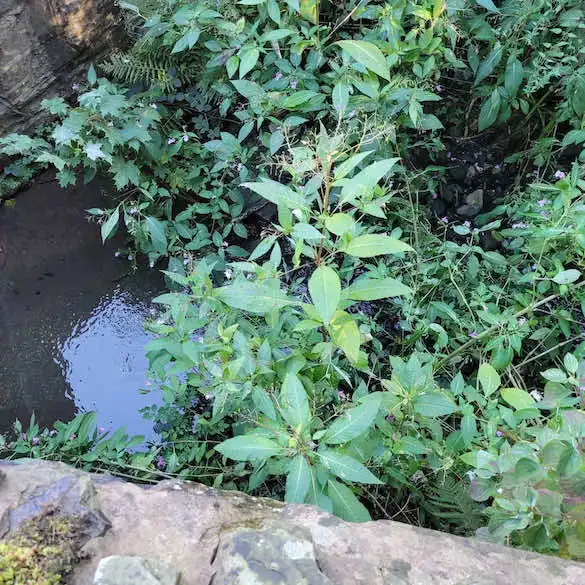Himalayan balsam identification guide
What is Himalayan balsam? To find out more, read our Himalayan balsam identification guide below. If you are still unsure, email us your photos and we will confirm whether it is Himalayan balsam for FREE
Quick facts
- Himalayan balsam's scientific name is Impatiens glandulifera.
- The plant was introduced to the UK by Dr John Forbes Royle around 1839.
- Himalayan balsam has a very shallow root system.
- Its leaves are star shaped (whorls of 3-5 leaves).
- Vibrant purple/pink flowers appear in June and July.
- One natural enemy of the Himalayan balsam is a rust fungus called Puccinia komarovii var. glanduliferae, released for trial in the UK in 2014 in an attempt to control the plant's spread.
Quick Links




What does Himalayan balsam look like?
Himalayan balsam (also known as Indian balsam or Policemen’s helmet) is an annual plant that grows up to around 2.5m tall.
- The stems are green, with red ridges, hollow and fleshy, with weak, shallow roots.
- The leaves are serrated, and grow to 25cm in a whorl shape, almost like a star around the stem.
- Himalayan balsam flowers appear in June and will develop in a range of colours including white, pink and purple.
- The flowers are followed by seed pods which, when ripe, open explosively when disturbed.
How do you identify Himalayan balsam in the Winter?
Whilst easy to identify in the summer, Himalayan balsam is a perennial plant, meaning that the above ground growth dies back in the winter. The stems, leaves and flowers die off each year and can leave next to no trace above ground. This can cause instability and erosion along riverbanks and watercourses (where Himalayan balsam is commonly found).
Look out for:
- Bare, eroded riverbanks where previously there was thick vegetation.
- Potentially slimy, rotting remains of stems.
- Small whorls of leaves in early spring.


How does Himalayan balsam spread?
Himalayan balsam is exclusively spread by dispersing its seeds. A light touch or a strong wind causes the ripe seed pods to explode, spreading up to 800 fertile seeds per plant up to 6m away from the parent plant. The seeds can remain viable in the soil for 2 years, meaning it can spread extremely quickly if the plant is not controlled each year.
The seeds are also very light, and can float on water, allowing migration and colonisation on waterways, where new infestations can be created easily where water slows, river levels regularly change, and especially in areas prone to flooding.
General gardening, landscaping, ground disturbance or construction can also cause spread seeds across a site where soil movement is not controlled.
Where does Himalayan balsam grow?
Originally introduced to the UK as an ornamental garden plant for its beautiful appearance, Himalayan balsam has escaped cultivation and can now be seen in most wetland habitats including riverbanks and streams, around ponds and lakes, wet ditches, meadows and wet woodlands across the UK.
Native to the Himalayan mountains, Himalayan balsam is hardy and can grow in most conditions including extreme heat, cold and wet weather.



Does Himalayan balsam look like Japanese knotweed?
Despite both being recognised as invasive plants by the Environment Agency, and having some similarities, they also have one notable difference: Himalayan balsam has bright pink flowers that are seed producing, whereas Japanese knotweed has smaller white flowers.
Although both Japanese knotweed and Himalayan balsam grow at an alarming rate, once established, the two are easily distinguishable by their completely different leaf shapes.
Why is Himalayan balsam a problematic invasive species?
There are multiple reasons why Himalayan balsam is a problem, and all of them create ecological issues:
- Himalayan balsam can outcompete other native vegetation – This is a problem because although Himalayan balsam is a good food source for many of our precious bees, the plant can easily outcompete other native vegetation, meaning no other flora can grow, ultimately reducing our native biodiversity. The species can quickly wipe out native bluebell colonies where it escapes into woodland, as rapidly emerging seedlings crowd out the light from woodland floors.
- Himalayan balsam causes erosion – As the plant is an annual, all the above ground material dies back at the end of the year, leaving large expanses of land void of vegetation, this means that they are more susceptible to erosion and damage from extreme weather.
- Himalayan balsam causes flooding – When the plants die back each winter, large expanses of riverbanks are left bare, with no protection from rising river levels. The dying plant material often enters our river systems, this can clog our waterways and cause flooding.


Is Himalayan balsam illegal?
Whilst it is not illegal to have Himalayan balsam on your own private land, you may be committing an offence under the Wildlife and Countryside Act (1981), The Invasive Alien Species (Enforcement and Permitting) Order 2019, or the Environmental Protection Act (1990) if you plant Himalayan balsam, move soil containing seeds, or cause it to grow in the wild. It is the landowner’s responsibility to ensure that the plant does not spread.
Given that Himalayan balsam spreads so easily by seed dispersal along waterways, landowners should take immediate action to control Himalayan balsam infestations.
Different penalties apply depending on the seriousness of the offence. You may get a warning, be served with a notice (e.g. a compliance or restoration notice where you must take steps to fix damage), be fined or even be sent to prison for a maximum of 3 months for a summary offence or 2 years for an indictable offence.
Is Himalayan balsam dangerous?
The plant is not harmful to touch or pull manually and isn’t poisonous to horses or any other animals.
In fact, in its native range, various parts of the plant are commonly used as a food source. Commonly used in curries and stews, the young shoots are also often used in salads, in addition to the seeds, known to have a pleasant nutty taste, whilst adding a nice crunch to salads!
The Himalayan Balsam plant has also been known to have other uses including using the oil from the seeds as a fuel for oil lamps.

Start fixing your invasive plant problem today by requesting a survey
Request a survey
Rest assured, where invasive species are identified at an early stage and tackled correctly, problems can usually be avoided. Our specialist consultants complete thorough surveys to identify the extent of the problem. Our plans aren’t one-size-fits-all; they’re customised to tackle the invasive species at your property effectively, taking account of all of your requirements.
What our clients say
Reviews
Richard responded to my email asking…
by Chocozicke
“Richard responded to my email asking for identification from pictures of the plants, immediately. This service is free of charge. All they ask for is a donation to a charity, which is really nice of them. Would definitely recommend them.”
Lovely company
by Jessie Cooper
“Lovely company. I am buying a flat in a high risk japanese knotweed area and spotted some suspicious looking shoots in the garden. Emailed photos to Environet who responded super speedily to reassure me it wasn’t knotweed. They asked for a donation to one of their justgiving charities instead of charging a fee for identification which is such a lovely idea!”
I contacted Environet Uk to discuss my concern about Japanese knotweed.
by Mr A
“I was advised how their identification system operated and was asked to send clear photographic images by email, which I did. Within 3 hours, I received a response. Very impressed by the professional manner this was dealt with. Thank you.”
Fantastic identification service!
by RF
“Fantastic identification service! I received an email response 1 hour after I sent the company an email with photos. I was advised that the weeds in the photos were not Japanese knotweed which was a huge relief.”
Japanese knotweed identification
by Lee Atkins
“I Can’t fault how professional this company is I spoke with a very professional lady on the telephone that gave me all the information and support we needed.This was followed up by a assessment of some pictures which has given us the piece of mind we need. Thank you”



